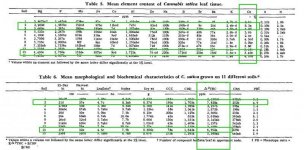reghatesschwag
New member
the science the science the experts the experts
do you know how many times ive seen the experts be completely wrong about things in my lifetime. that doesnt make them bad people. alot of times they were just trusting the experts before them.
my cousin art farmed in the dakotas in the 70s. high clay soils. lots of potassium. the fellas at the universities told everyone that potassium was in excess and certainly not needed. yet him and his friends all had yield increases when they added it. turns out base percentage wise the potassium was pretty low. the universities didnt believe in base saturation back then. alot still dont. neil kinsey wrote about it in his book.
now i dont know if getting my soil to 85% calcium saturation will increase my tissue calcium but i dont know it wont either. i plan to find out. i listen to slownickel because steve solomon respects him and i loved all of solomons books. plus it makes sense that increasing the base calcium will increase the tissue calcium.
one more story about experts and i will stop rambling. i hate cucumbers but my niece loves them so i learned how to grow them. tried this new variety that the local extension expert said yielded poorly but tasted great. i got triple the yield he said was possible and had .8 % phosphorus in the tissues all season long. experts said that was too high too. she loved them though. they stopped selling that variety due to poor demand. cant even remember what it was called. maybe it was a fluke? maybe the cucumbers didnt care what the experts thought.
i was watching this crime show the other day and some fire expert testified this guy started a fire. turns out the expert was using outdated research. neither he nor the prosecutor cared. guy got convicted but finally got out of jail on appeal. the expert still testifies to this day with the outdated research.
im not saying that all experts are wrong and to ignore them. some of them do brilliant work. but me personally i like to find out for myself.
do you know how many times ive seen the experts be completely wrong about things in my lifetime. that doesnt make them bad people. alot of times they were just trusting the experts before them.
my cousin art farmed in the dakotas in the 70s. high clay soils. lots of potassium. the fellas at the universities told everyone that potassium was in excess and certainly not needed. yet him and his friends all had yield increases when they added it. turns out base percentage wise the potassium was pretty low. the universities didnt believe in base saturation back then. alot still dont. neil kinsey wrote about it in his book.
now i dont know if getting my soil to 85% calcium saturation will increase my tissue calcium but i dont know it wont either. i plan to find out. i listen to slownickel because steve solomon respects him and i loved all of solomons books. plus it makes sense that increasing the base calcium will increase the tissue calcium.
one more story about experts and i will stop rambling. i hate cucumbers but my niece loves them so i learned how to grow them. tried this new variety that the local extension expert said yielded poorly but tasted great. i got triple the yield he said was possible and had .8 % phosphorus in the tissues all season long. experts said that was too high too. she loved them though. they stopped selling that variety due to poor demand. cant even remember what it was called. maybe it was a fluke? maybe the cucumbers didnt care what the experts thought.
i was watching this crime show the other day and some fire expert testified this guy started a fire. turns out the expert was using outdated research. neither he nor the prosecutor cared. guy got convicted but finally got out of jail on appeal. the expert still testifies to this day with the outdated research.
im not saying that all experts are wrong and to ignore them. some of them do brilliant work. but me personally i like to find out for myself.




